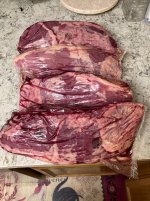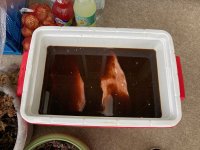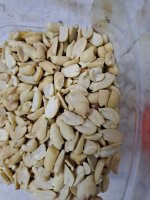I'm in Sweden 🙂 We send a piece of the animal (most often a bit of the kidney, "njurtapp" in swedish) for test before we consume it. You get the answer the day after you post it most of the times.I have tried wild boar filet 🙂lickface🙂, however here in Sweden we are warned that wild boar may contain trichines, so being sure to cook the meat is essential. But wild boar and pork are two different species, especially on the plates.
We can discuss this further by PM aka Conversation.Maybe I ought to drive up with the F4 and we can listen, eat some bacon and drink some IPA.
I have to say , its not regular food here, but i had the opportunity to try. No regrets.Wagyu? Kobe? You guys have expensive tastes. Ground hamburger mince here. I live on AU$53 a week for food.
I like hamburgers, homemade, ground minced beef here costs 25 $ /kilo or more.
53 ozzie bucks for food here per week would be the most effective diet of the world for sure.
We have also swiss beef, usually just expensive. I prefer beef from argentina by far, double price, i take half portion , everything fine 🙂
Frozen small size shrimps are 22 $kilo, tall size 50 $, organic quality 70 $.
Simple white bread 4 $ kilo, good bread 10 $ kilo, so it is.
Good ozzie red wine is 12 $ bottle, from argentina the same, the real good one from Bordeaux or Burgundy 120 up to 300 bucks.
We can see that stuff everwhere, but not affordale for regular workers, so what...
High Life 🙂
I have to say , its not regular food here, but i had the opportunity to try. No regrets.
I like hamburgers, homemade, ground minced beef here costs 25 $ /kilo or more.
53 ozzie bucks for food here per week would be the most effective diet of the world for sure.
We have also swiss beef, usually just expensive. I prefer beef from argentina by far, double price, i take half portion , everything fine 🙂
Frozen small size shrimps are 22 $kilo, tall size 50 $, organic quality 70 $.
Simple white bread 4 $ kilo, good bread 10 $ kilo, so it is.
Good ozzie red wine is 12 $ bottle, from argentina the same, the real good one from Bordeaux or Burgundy 120 up to 300 bucks.
We can see that stuff everwhere, but not affordale for regular workers, so what...
High Life 🙂
I have always enjoyed the fact that what is a luxury in many nations is within reach of the middle class in the USA.
We can get awesome wines from all over the World for less than $20 USD per bottle.
American Wagyu is about $25 per pound for ribeye cuts, the USDA Prime Grade is a little bit less. And it's a very nice Sunday Dinner to make a 3 lb, 3 inch thick steak in the Sous Vide, then finishing it on the grill and serving it, sliced, on a platter. As you note, eat less beef, but better quality.
Have you tried aging your beef? It can be spectacular!
Looks very good. We go through a lot of ginger but have not candied it. We use it in our stir fries, marinades, drinks both hot and cold and of course as the accompaniment for sashimi, aka pickled.Ginger candy ready...
Last edited:
I would not be able to afford to eat like I do if I lived there.High Life
A man after my heart.a 3 lb, 3 inch thick steak in the Sous Vide, then finishing it on the grill and serving it, sliced,
Tony, I will answer your PM later today.
Back bacon is all but gone. We give a lot away to friends, family and those not able to cook like they used to.
Next up is beef. Four pieces totaling 32 bs., eye of round destined for jerky. Now trimmed and in the marinade, weight then added to submerge it and the lid put on. Rotated after three days, total of six days in the juice.
This time it's a coffee, sugar, salt and chili flake mixture. At the end it comes out, dried for a day then smoked.
Next up is beef. Four pieces totaling 32 bs., eye of round destined for jerky. Now trimmed and in the marinade, weight then added to submerge it and the lid put on. Rotated after three days, total of six days in the juice.
This time it's a coffee, sugar, salt and chili flake mixture. At the end it comes out, dried for a day then smoked.
Attachments
Last edited:
Oh, the jet streams have shifted direction ...
I presented todays dinner with a question to my Swedish forum members: What's your favourite dish or food? If it is something that isn't to exclusive, rather easy to prepare and something people may tend to eat often, I'd say very many answer lasagne or pizza.
This one will divided into 6 servings ... well five, and will be kept in the fridge for days I cannot come up with any good ideas. Most of ingredients bought "on coupons", so USD2 per serving.
I presented todays dinner with a question to my Swedish forum members: What's your favourite dish or food? If it is something that isn't to exclusive, rather easy to prepare and something people may tend to eat often, I'd say very many answer lasagne or pizza.
This one will divided into 6 servings ... well five, and will be kept in the fridge for days I cannot come up with any good ideas. Most of ingredients bought "on coupons", so USD2 per serving.
We had lasagne too this evening, but not as you know it. for us meat-free fake lasagne 😀Lasagne.
@NareshBrd peanuts may be a good source of protein but they are 50% fat (like most nuts). Those of us on meat free diets need the fat of course. Carnivores may not 😀
That would get pedantic, the fat content in beef and goat is very different...
And the USA has an average meat consumption, per capita, of more than 100 kilos per person annually.
India is at 3.6 kilos, much lower.
So the quantity of fat, proteins, and preservatives of meat origin will be quite different in the diet of people from both countries.
https://en.wikipedia.org/wiki/List_of_countries_by_meat_consumption
Also, the yield of edible (including mechanically treated / recovered) meat from animals is about 25-30%, in some cases 35%.
The rest is skin, bones and non edible parts.
Plant food is rather more useful, the waste can be used for other purposes.
That would be getting on the toes of meat lovers if I digress further, just bear in mind that more meat is consumed in countries where the climate will not allow plants to grow in winter.
We all need to eat, so the animals became the food source for people in cold climates.
In ancient times, vegetables were not transported far away, unlike now, where you have bananas from South America being sold in Germany, and flowers in winter from Israel and India coming to Europe...
And organic beef from Uruguay and New Zealand being sold in Sweden and Switzerland.
Many things have changed, we take some things for granted , not realizing the effort taken to ship perishable items over long distances.
And the USA has an average meat consumption, per capita, of more than 100 kilos per person annually.
India is at 3.6 kilos, much lower.
So the quantity of fat, proteins, and preservatives of meat origin will be quite different in the diet of people from both countries.
https://en.wikipedia.org/wiki/List_of_countries_by_meat_consumption
Also, the yield of edible (including mechanically treated / recovered) meat from animals is about 25-30%, in some cases 35%.
The rest is skin, bones and non edible parts.
Plant food is rather more useful, the waste can be used for other purposes.
That would be getting on the toes of meat lovers if I digress further, just bear in mind that more meat is consumed in countries where the climate will not allow plants to grow in winter.
We all need to eat, so the animals became the food source for people in cold climates.
In ancient times, vegetables were not transported far away, unlike now, where you have bananas from South America being sold in Germany, and flowers in winter from Israel and India coming to Europe...
And organic beef from Uruguay and New Zealand being sold in Sweden and Switzerland.
Many things have changed, we take some things for granted , not realizing the effort taken to ship perishable items over long distances.
Last edited:
Here in India, we sometimes add lemon grass, holy basil, mint, shredded ginger, cardamom and other things to tea while it is boiling.
Not all together, ginger + cardamom is okay, the rest are exclusive.
There is even a chocolate tea powder, it makes the tea taste a bit like chocolate, and also different spice sellers offer tea masala, basically ginger powder, cardamom and other spices in different proportions.
We add milk, tea leaves, sugar and so on to water in a pan, and boil it, how long is an individual choice.
It is then sieved into cups and consumed, the English pot style is quite different, in our opinion quite weak.
I believe the Russian style of using a samovar is similar to our style.
Not all together, ginger + cardamom is okay, the rest are exclusive.
There is even a chocolate tea powder, it makes the tea taste a bit like chocolate, and also different spice sellers offer tea masala, basically ginger powder, cardamom and other spices in different proportions.
We add milk, tea leaves, sugar and so on to water in a pan, and boil it, how long is an individual choice.
It is then sieved into cups and consumed, the English pot style is quite different, in our opinion quite weak.
I believe the Russian style of using a samovar is similar to our style.
@NareshBrd tell me how do you roast your peanuts over there, such as your way of roasting, temperature, time, added salt, spices, and do you also use oil?
I have tried at home, it works quite well in the oven with even result, but it's consuming too much energy so I have resorted to the fry pan under a lid, which also works well, but the temperature have to be set quite low to avoid burning the side of the nut lying down, otherwise one have to stand next to the pan stirring constantly for a long time, I wonder how the peanuts are roasted industrially, time to search..
A bit of search with the essential snippets:
And for the DIY roasters:
Another one:
https://www.wikihow.com/Roast-Peanuts
And many more recipes on the net, from what I gleaned over there are many ways how to roast nuts, one method mentioned using sand.
Another reason I would prefer roast myself is to get rid of the added oil that is used in ready roasted peanuts from the grocery store.
I myself add initially a bit water into the pan mixed in with salt and the nuts, have to be a bit frugal with the water otherwise the nuts may become too damp prolonging the roasting.
I have to say it's quite a time consuming process for something that at first appearance seems rather trivial, especially when using the fry pan method, I would say it takes at least some 45 minutes, but that one recipe above mentioning turning off the oven and let the nuts sit in there seems like an interesting fail-safe approach I have to give a try.
I have tried at home, it works quite well in the oven with even result, but it's consuming too much energy so I have resorted to the fry pan under a lid, which also works well, but the temperature have to be set quite low to avoid burning the side of the nut lying down, otherwise one have to stand next to the pan stirring constantly for a long time, I wonder how the peanuts are roasted industrially, time to search..
A bit of search with the essential snippets:
https://www.sciencedirect.com/topics/pharmacology-toxicology-and-pharmaceutical-science/peanutA typical protocol for dry-roasted peanuts is exposure to 160 °C for 20–30 min. Seed coats are generally removed before applying oil and salt. In oil-roasting, blanched peanuts are immersed for 3–5 min in heated oil. After roasting the peanuts are then subjected to air cooling and salting with about 1.8–2.2% salt.
https://www3.epa.gov/ttnchie1/ap42/ch09/final/c9s10-2b.pdfDry roasting:
Batch roasters are typically natural gas-fired revolving ovens (drum-shaped). The rotation of the oven continuously stirs the peanuts to produce an even roast. Oven temperatures are approximately 430°C (800°F), and peanut temperature is raised to approximately 160°C (320°F) for 40 to 60 min...
...Dry roasted peanuts are cooled and blanched. Cooling occurs in cooling boxes or on conveyors where large quantities of air are blown over the peanuts immediately following roasting. Cooling is necessary to stop the roasting process and maintain a uniform quality
Oil Roasting:
Before roasting, the peanuts are blanched to remove the skins. Continuous roasters move the peanuts on a conveyor through a long tank of heated oil. In both batch and continuous roasters, oil is heated to temperatures of 138 to 143°C (280 to 290°F), and roasting times vary from 3 to 10 minutes depending on desired characteristics and peanut quality...
...Coconut oil is preferred, but oils such as peanut and cottonseed are frequently used. Cooling also follows oil roasting, so that a uniform roast can be achieved. Cooling is achieved by blowing large quantities of air over the peanuts either on conveyors or in cooling boxes.
And for the DIY roasters:
- Preheat the oven to 500 degrees F (260 degrees C).
- Arrange peanuts in a single layer on a cookie sheet, and place in the preheated oven.
- Turn the oven off. Leave peanuts in the oven for 1 hour without opening the door. Serve warm or at room temperature.
Another one:
https://www.wikihow.com/Roast-Peanuts
And many more recipes on the net, from what I gleaned over there are many ways how to roast nuts, one method mentioned using sand.
Another reason I would prefer roast myself is to get rid of the added oil that is used in ready roasted peanuts from the grocery store.
I myself add initially a bit water into the pan mixed in with salt and the nuts, have to be a bit frugal with the water otherwise the nuts may become too damp prolonging the roasting.
I have to say it's quite a time consuming process for something that at first appearance seems rather trivial, especially when using the fry pan method, I would say it takes at least some 45 minutes, but that one recipe above mentioning turning off the oven and let the nuts sit in there seems like an interesting fail-safe approach I have to give a try.
This is is the method used, fine earth transfers the heat evenly, common salt with a little rock salt is added for flavor. Wood shavings are the commonly used fuel.
I buy them, many small factories near my house, I eat 50 grams daily....
Microwave 4 minutes at 50 percent power, result will be close enough.
Oil is never added here in India.
Water is also never added.
The 'kadhai' (half spherical vessel above) needs to be on the thick side, and iron. Other metals burn away.
Most households do not have such thick vessels, these are more than 4 mm thick, that also diffuses the heat.
Unless you have heat transfer media like fine sand, earth, or stone powder, the other methods do not work.
I have seen a pillar drill turning a paddle slowly to stir the roasted material, set at its lowest speed.
The flavor comes from the changes due to roasting, and the release of the internal oil. Shelf life is like 2 weeks to a month after roasting.
That said, one of my friends, lives in Virginia, always takes them back when he comes to India, he says the American nuts are tasteless, they are bland it seems.
So the nuts themselves need to be of the right quality.
The South Indian nuts are smaller, with a light coffee colored inside. They have a fried sort of taste when roasted.
And the North Indian nuts are bland, though they look like the nuts in my photo, which are grown in Gujarat.
It is like tea, Chinese, Kenyan, Assam,Darjeeling, Nilgiri, Ceylon, and so on!
I pay between $2 and $3.50 a kilo, depending on size and quality of the nuts.
For my normal purchase of half a kilo, too much trouble, as the roasters add only 25 cents per kilo as their process charges over the price of the raw nuts. So I buy them ready packed at the factory / workshop.
The High Street price can be triple, as the shop keepers add their margins...
Last edited:
- Home
- Member Areas
- The Lounge
- The food thread




